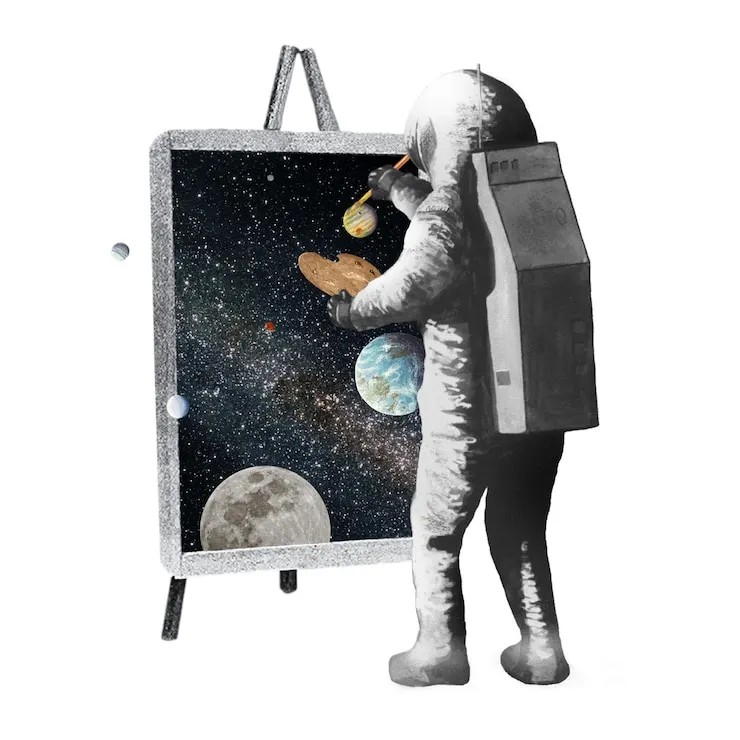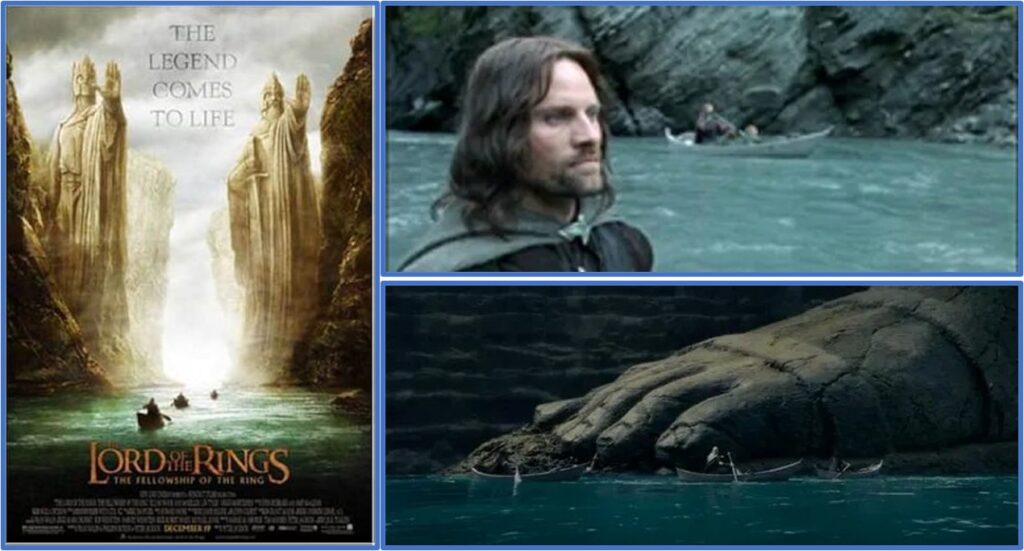The finish carpentry of world building. Essay. 1600 words. 8-minute read.

Art As a World Building Tool
By Ray Tabler
When telling a science fiction or fantasy tale, there are any number of tools which can be employed to set the scene for the reader/viewer. Flying cars, elves, robots, dragons, aliens, and ray guns all signal a futuristic, extraterrestrial, or magical back drop in an overt manner. But art is a subtle clue that might escape notice, while still whispering vital messages in the reader’s ear.
A useful analogy likens world building for a story or novel to constructing a house. First of all, there is the foundation. The ecology of a planet or the geography of a fantasy realm establishes the stage upon which the tale unfolds. Framing carpentry, and masonry is the society in which the characters live. Piping and electrical are the characters and the conflict which sets them at odds, and provides drama. Then there are a number of final touches which transform the house from a soulless structure into a home: finish carpentry, decorating, etc… One of those subtle, but important, aspects is how the people (beings?) in the story create and view art.
Artwork has been a part of being human since we’ve been human. Our prehistoric ancestors left images of people, animals, and scenes on cave walls and hillsides and carven figures everywhere for tens of thousands of years. We don’t know why they considered it worth the effort to create those images, and carve those figures. But they did. And, I doubt that impulse will disappear in the future, on other worlds, or in other realms. The writer can utilize the compulsion to create art to telegraph aspects of a created world, without the reader/viewer even noticing.
What art says about a society – Scholars who study ancient Egyptian artwork have noticed that it follows strict rules. Size and placement of figures on an Egyptian wall mural indicate social status, in defiance of a realistic depiction. Body positions, and clothing carry similar cues. These images weren’t primarily for aesthetics. They were propaganda, reinforcing the conditioning of a rigid, hierarchical society.
A similar observation might be made of medieval art in Europe. For something like a thousand years, the bulk of European art was channeled through the Catholic church. As such, almost all of it focused on glorifying and promoting Christianity. Which doesn’t mean it was bad art, just that aesthetics and style were secondary considerations.
Ancient Greek and Roman art were, in comparison to medieval examples, much more appealing, at least to our eyes. The ancients depicted gods in realistic human forms, reflecting their view of the occupants of Olympus as immortal, mighty in power but petty and human in behavior. Christian art took a different view point.
The renaissance attempted to integrate both outlooks, depicting God in human form. The change mirrors the opening up of old ways to new interpretations. Slowly, the reign of religious subject matter declined. By the age of enlightenment, the physical world, not the spiritual, dominated. In the modern era, even the realistic depiction of people and places has given way to abstract and surrealistic art, arguably driven by artists seeking purpose in the wake of the technological innovation of photography. The structure of a society drives what kind of art is produced. The writer can drop hints about what kind of world he’s building by what his created society (societies?) focuses its art on, and how it chooses to execute it.
Much of Islamic art is forbidden to depict human forms. Which forces an emphasis upon geometric patterns instead. Largely in defiance of the opulence of art within Catholic churches, some Protestant denominations purged their sanctuaries of all but unadorned crosses. That reflected the sober, austere faith of the Reformation ideal.
The above is a meditation on how religion exerted a strong influence on art over the last few millennia. The science fiction or fantasy writer might use art to signal what kind of world he has built in terms of other driving forces as well. Art is a powerful propaganda weapon. Centrally-directed societies tend to deploy art as a way to maintain control over the populace. In the former Soviet Union, artists were strongly encouraged to create in the style of socialist realism. Strong, contented, dedicated peasants and workers were depicted hard at work, doing what the state told them to do.
Before we become too smug about the heavy-handed propaganda of socialism, take a look at a Western magazine or watch a Network TV show. Artists in the free world are strongly encouraged (via money) to sell products in advertising. The message is that the cool kids drive this car, wear those clothes, use that toothpaste. The powers that be employ art for their own purposes. So, pick you poison, and drink it down.
If the writer is aware of the underlying rules of the game, he can use it to give clues about the world built. Honestly, there is no practical, physical purpose served by art, except its benefit to the soul. The poor must often prioritize the body over the soul. Only those in charge have the luxury of commissioning artworks, of decreeing what is art and what isn’t. That is a sly way to signal who rules in a fictional world. Who do the artists ultimately work for?
Art and backstory – An example of using art in a fantasy story are the Argonath, in Lord of the Rings. The Argonath are the two, gigantic statues of the founding kings of Gondor, which the members of the Fellowship pass on the way down the river Anduin. These skyscraper-scale figures have differing effects upon Aragon and Boromir. To Aragorn, the descendant of the carven kings, it evokes the responsibility he is struggling to shoulder. For Boromir, the statues remind him of Gondor’s long, slow decline from greatness under the management of his family of stewards.

Art and technology – Art used to be limited to images painted, or carved into a surface, or sculpture. There were also performed arts, like poetry, song, dance, and drama. But those are inherently ephemeral in nature, Once the performance is over, it exists only in the memory of those who enjoyed it. Or those who didn’t in the case of critics.
Technical progress has changed that. Photography, motion pictures and video, sound recordings have allowed us to capture and preserve ephemeral art. Photography, in particular, threatened artists with obsolescence. In reaction, abstract and surrealistic art was born. In effect, technology expanded art, for good or for bad. Technology reopens the question of what art might be. And so, a banana duct-taped to a wall is now art (so say those with enough excess disposable income). Whether that is a triumph or a tragedy is beyond the scope of this essay.
The pace of technological change is not likely to slacken, so expect more expansion of the boundaries of art. A short story I once read (apologies, I cannot recall the author or title) told of genetically engineered girls with openings in their bones. They made music by dancing in the wind. What does this practice tell us about the fictional society that employs it? Callous hubris? Before we judge them, remember that up until the 1700s choirboys in European cathedrals and operas were routinely gelded to preserve their angelic soprano voices.
Genetic manipulation is a rich vein of fictional futuristic art to mine. Succumbing to the temptation to create designer organisms for purely aesthetic reasons speaks volumes about a setting with an economy of description. Miniature elephants the size of toy poodles would probably sell like hotcakes. Another possibly irresistible urge is painting on a cosmic canvas. In the Assiti Shards/Ring of Fire universe, Eric Flint imagined an alien race who coldheartedly spread chaos across time and space in creating temporal artwork that displaced entire towns and tribes to other times. The time displacements were only side effects of fashioning the Assiti artwork, like stone chips from a sculptor’s bench falling on ants. In one of my novels, a botched project to create a picturesque artificial planetary ring system devastates an inhabited world.
Architecture is art as well (or at least art-adjacent). Architecture lends itself to films and TV, because it is overwhelmingly visual in nature. That makes it tough to employ it in written works. Although, Ayn Rand did a good job in The Fountainhead. Movies like Metropolis, Bladerunner, and Gattaca filmed against brooding, oppressive modern architecture backdrops to set a mood of futility. In contrast, The 5th Element follows its characters through shabby/futuristic tenements, bustling art deco street scenes, and a floating luxury resort hotel to paint a mixed, nuanced vision of a complicated future.
And then there is AI. It might be argued that we are currently living through a science fiction story, a story not possible even five years ago. Much like photography challenged artists in the 1800s, AI technology has raised thorny questions. Is the output of large language models actually art, or simply automated, industrialized plagiarism? Will AI get better at art? At what point would AI-generated art be considered truly art? By what metric? What will artists do if AI art is indistinguishable from human-generated? I suspect efforts to create what machines cannot will spawn art as new and controversial and profoundly distinct as abstract and surrealism from what came before. Too bad reality got ahead of us before we could write science fiction about it.
END,
Shameless Self-Promotion Section:
Check out my novels at Histria Books https://histriabooks.com/product-tag/ray-tabler/
- The Diesel-Powered Starship (due for release in September 2025) https://histriabooks.com/product/the-diesel-powered-starship/
- A Grand Imperial War (Book 1 of the Grand Imperial series) https://histriabooks.com/product/a-grand-imperial-war-grand-imperial-series-book-1/
- A Grand Imperial Heir (Sequel to A Grand Imperial War) https://histriabooks.com/product/a-grand-imperial-heir-grand-imperial-series-book-2/
- Fool’s Paradise https://histriabooks.com/product/fools-paradise/
And visit my website https://raytabler.com/ for Science Fiction You Can Enjoy!
